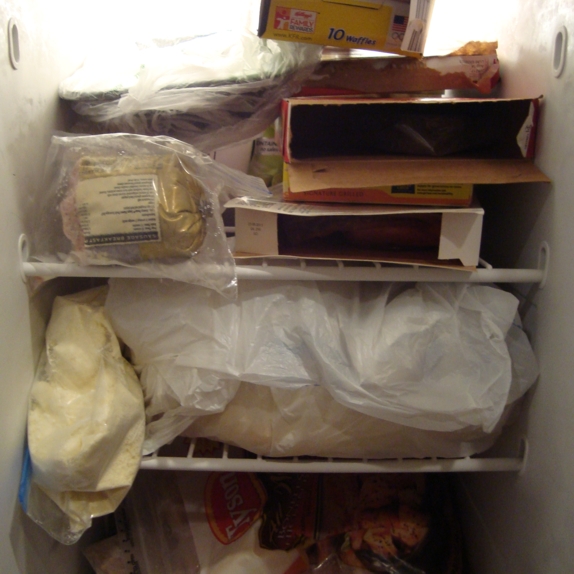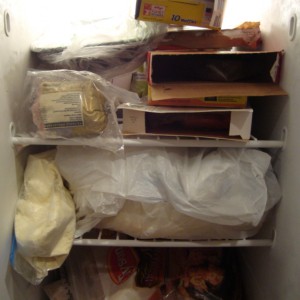by Amy Mullins, PhD, RDN | Mar 23, 2015

Prepare a shopping list
It seems that we are rushing here and there, doing things at the speed of light. We may find ourselves consumed by work, meetings, school, sports practice for the kids… an endless list of things to keep us active, stressed, and often frantic.
Life has become so busy that we often forget to take care of ourselves, which can dramatically increase the risk of preventable chronic diseases. According to the Centers for Disease Control (CDC), chronic diseases such as high blood pressure, high cholesterol, and type-2 diabetes accounted for over 26% of deaths in the United States in 2013. Chronic stress, combined with poor planning, can likely lead to unhealthy exercise and eating habits for yourself and your family.
Planning ahead is critical in side-stepping the impacts of poor nutrition and obesity-related chronic diseases.
Follow these simple tips:
- Plan meals (including brown-bag lunches and snacks) you and your family like that include lean protein, whole grains, low-fat dairy, and lots of fruits and vegetables.
- Save time and money by making a grocery list before going to the store.
- Be a master planner! Save your weekly meal plans and grocery lists to use again another week.
- Avoid take-out and make foods that you can bring to work the next day for lunch.
- Avoid the vending machine and bring snacks to work like nuts, fresh or dried fruit, or whole-grain crackers and hummus.
- Don’t forget to eat breakfast! A quick bowl of cereal with low-fat milk and a small cup of orange juice can help you make it to lunchtime.
- Carry a tumbler! Fill up on water all day, anywhere and everywhere, to keep you hydrated and help you to avoid sugary drinks and sodas.
Make sure to plan time each day to be active. Taking short walks and stretching at your desk can make a world of difference in your health and attitude. For additional information on healthy eating, please visit ChooseMyPlate.gov and Nutrition.gov.
by Kristin Jackson | Mar 17, 2015

Bindaas Madhavi. (2011) Listen to Your Kids.
Most parents would not allow their child to play in the street or to touch a hot stove because parents understand that these actions have consequences and the consequences are serious. If you don’t talk with your child about money and allow them to observe you exhibiting positive financial behaviors, this can also have serious consequences. One indicator of an individual’s financial capabilities is their credit score. A poor credit score can impact an individual’s ability to get a job, secure housing, purchase reliable transportation and access other forms of credit.
According to FINRA Investor Education Foundation State Financial Education Mandates, three years after Georgia, Idaho and Texas implemented a financial education mandate, credit scores of participants improved. In 2014, Florida also voted to adopt financial education into its social studies standards for students in grades K-12 and financial education is now a graduation requirement. While incorporating financial education into schools is an important step, parents still play an important role in financial socialization (establishing what is normal in terms of financial behaviors). In fact, research shows that time preference patterns and delay of gratification patterns are set by age five or before a child reaches kindergarten. Time preference patterns and delay of gratification patterns are often exhibited by adults through savings and budgeting. In a recent study by Cho, Gutter, Kim and Mauldin, the researchers found the effects of financial socialization had significant effect on the financial behaviors of low- to moderate-income adults aged 24-66, indicating that the time preference patterns children develop in youth could last a lifetime.
UF/IFAS Extension Northwest District Family & Consumer Sciences (FCS) Agents know that, as parents, you want to protect your child or children from things that have negative consequences whether it be an inattentive driver, a hot stove, or a poor credit score. One of the things parents can do immediately, to impact what their child is learning about money and how their child is being financially socialized, is to talk with their child about money. Some ideas to get your family conversations about money started are to discuss:
– Wants versus needs
– The grocery budget
– Household expenses
– How your child can earn/save money
If you are still a little nervous about starting the conversation as a result of concerns about your own financial capabilities, contact your local UF/IFAS Extension Office and ask about our Master Money Mentor Program or upcoming financial classes. If you can’t wait for a class, check out these additional resources:
Talking to Children about Money: http://www.ag.ndsu.edu/pubs/yf/famsci/fs1441.pdf
Are Your Children in the Middle of your Conflict or Divorce? http://goo.gl/lpXwwc
9 Important Communication Skills for Every Relationship http://edis.ifas.ufl.edu/pdffiles/FY/FY127700.pdf
Remember a family conversation about money is one conversation that is too important to wait. Make a money date with your child or children today!
References:
Cho, Gutter, Kim and Mauldin. (2012). The Effect of Socialization and Information Source on Financial Management Behaviors among Low-and Moderate-Income Adults. Family & Consumer Science Research Journal. 40(4): 417-430
Council for Economic Education. (2015). Survey of the States. Retrieved 16 March 2015 from http://www.councilforeconed.org/news-information/survey-of-the-states/
National Financial Educators Council. (2013) Financial Education Impact. Retrieved 16 March 2015 from http://www.financialeducatorscouncil.org/financial-literacy-statistics/
by Dorothy C. Lee | Mar 17, 2015

Egg food safety at Easter time
Easter activities often include eggs. During the Spring holiday, eggs are both a decorative craft object and an inspiration for springtime fun and games, and, oh by the way, they are fun to eat too.
Eggs and egg products can be an important part of your diet. Although there are many myths and misconceptions about how to safely cook and handle eggs, all it really requires is care. By following a few simple guidelines, eggs and egg products can play a valuable and economic role in your holiday menu.
To avoid the possibility of foodborne illness, fresh eggs must be handled carefully. Even eggs with clean, uncracked shells may occasionally contain bacteria called Salmonella that can cause an intestinal infection. The U.S. Food and Drug Administration (FDA) is working to prevent this problem in eggs by requiring that egg producers obtain chicks that are certified Samonella-free, that the hens are kept in houses that are free from rodents and other Salmonella carrying sources, that the houses are continually tested for Salmonella, and that the eggs are stored at temperatures that retard Salmonella growth. Consumers play a large role in this prevention strategy. In fact, the most effective way to prevent egg-related illness is by knowing how to buy, store, handle and cook eggs—or foods that contain them—safely.
Following these instructions is important for everyone, but especially for those most vulnerable to foodborne disease—children, the elderly, and persons with weakened immune systems.
Buy Right
- Buy eggs only if sold from a refrigerator or refrigerated case.
- Open the carton and make sure that the eggs are clean and the shells are not cracked.
- Refrigerate promptly.
- Store eggs in their original carton and use them within 4 to 5 weeks.
Keep Everything Clean
Before preparing any food, remember that cleanliness is key!
- Wash hands, utensils, equipment, and kitchen work surfaces with hot, soapy water before and after they come in contact with eggs and egg-containing foods.
Cook Thoroughly
Cook eggs thoroughly. Thorough cooking is perhaps the most important step in making sure eggs are safe.
- Cook eggs until both the yolk and the white are firm. Scrambled eggs should not be runny.
Serve Safely
Bacteria can multiply in temperatures from 40°F (5°C) to 140°F (60°C), so it’s very important to serve foods safely.
- Serve cooked eggs and egg-containing foods immediately after cooking.
- For buffet-style serving, hot egg dishes should be kept hot, and cold egg dishes kept cold.
- Eggs and egg dishes, such as quiches or soufflés, may be refrigerated for serving later but should be thoroughly reheated to 165°F (74°C) before serving.
Chill Properly
- Cooked eggs, including hard-boiled eggs, and egg-containing foods should not sit out for more than 2 hours. Within 2 hours, either reheat or refrigerate.
- Use hard-cooked eggs (in the shell or peeled) within one week after cooking
On the Road
- Cooked eggs for a picnic should be packed in an insulated cooler with enough ice or frozen gel packs to keep them cold.
- Don’t put the cooler in a hot car—carry it in the air-conditioned passenger compartment of the car.
Safe Handling Instructions
To prevent illness from bacteria: keep eggs refrigerated, cook eggs until yolks are firm, and cook foods containing eggs thoroughly.
Hard-cooked Easter eggs can help stretch your food dollars. Packed with high-quality protein, vitamins, and minerals, they add good nutrition when included in casseroles, sandwiches, and salads. Remember, hard-cooked eggs should be refrigerated as much as possible between cooking, decorating, and the hunt or the display.
However they are used, eggs are delicious, nutritious, and economical.
For further information, contact
Dorothy C. Lee, C.F.C.S.
Family & Consumer Sciences Agent
UF IFAS Extension Escambia County
(850) 475-5230
dclee@ufl.edu

by Kristin Jackson | Mar 13, 2015

Bertholf. (N.D.) Juicing from http://goo.gl/Neu02U
Don’t fool yourself into thinking that drinking 100% fruit juice is the same as eating the whole fruit. Researchers from the Harvard School of Public Health found two key things that may have you re-thinking your breakfast drink:
- In many cases, fruit juice contains as much sugar as soft drinks, although the sugar in fruit juice is naturally occurring.
- Despite the calories in fruit juice, people who drink juice don’t feel as full as if they ate the fruit, so they end up consuming more calories.
When it comes to your children, over-consumption of fruit juice or consuming greater than 12 ounces a day was found to be associated with short stature and obesity. In 2006, 10% of all annual medical spending went to treating obesity-related diseases. When it comes to children specifically, research estimates the average total health care expenditures for a child treated for obesity is nearly three times higher than the average health care cost for all other children.
At this point, you probably are asking, “If juice is out, then what should I do?” UF/IFAS Extension has a solution for you. Try remixing your current plate. Instead of going for the orange juice, grab an orange. Substitute your fruit juice for its whole fruit counterparts. If you decide to make the swap, you will find yourself in need of a drink; try water or milk. For more resources on building a healthy plate, visit:
ChooseMyPlate.gov
Healthy Eating: Smart Snacking
Choose MyPlate: Drink Water Instead of Sugary Drinks
References:
Dennison, B., Rockwell, H. and Baker, S. Excess fruit juice consumption by preschool-aged children is associated with short stature and obesity. Pediatrics 100(4):733, 1997
Department of Nutrition at Harvard School of Public Health. Fact Sheet: Sugary Drink Supersizing and the Obesity Epidemic. Nutrition Source, 2012
Finkelstein EA, Trogdon JG, Cohen JW, Dietz W. Annual Medical Spending Attributable to Obesity: Payer- and Service-specific Estimates. Health Affairs, 28(5): w822-831, 2009.
Marder W and Chang S. Childhood Obesity: Costs, Treatment Patterns, Disparities in Care, and Prevalent Medical Conditions. Thomson Medstat Research Brief, 2006

by Angela Hinkle | Mar 13, 2015

UFOs in Your Freezer
Does your kitchen freezer resemble an archaeological dig in an iceberg? Do you ever see what you think is what you’re looking for in the very back? As you reach for it, half of everything else falls out onto your kitchen floor? UFOs (Unidentified Frozen Objects) end up everywhere. Your reaction may be something like, “*#@&!”
This may be a sign that it’s time to organize your freezer. “Are you kidding me? Who has time for that?,”’ you may ask. You might even roll your eyes.
Here are a few tips that may help:
- Clean it out and when in doubt, throw it out.
Start with the hardest part first – trust me, it gets much easier after you’ve completed this step. Go through all the contents of your freezer and throw out what is freezer-burned or otherwise unusable. If you really have no idea if it’s animal, mineral, or vegetable, or how long it’s been in your freezer, it’s time to toss.
If you’ll take a quick moment to label and date the food before you put it in the freezer, you’ll save your sanity later by avoiding guess work. (A friend told me she pulled the plastic tub of fundraiser cookie dough out of the freezer as a treat for her kids. What a surprise to be treated instead to vegetable stew.) Label using wax crayons, pencil, or marker pens on stickers or tape that can stay put in freezing temperatures. And yes, if you are so inclined, there are apps for labeling. By the way, the sniff test is usually useless, since most frozen foods won’t have much of an aroma.
- Freeze in useable portions.
Congratulations! You saved money buying the chicken in that family-sized pack. Keep food safe and manageable by individually wrapping pieces, then freezing in a large, labeled, plastic zip-type bag. Then you only take out the amount you want. You may lose more money than the original savings if you have to thaw out and possibly throw out a gigantic clump of chicken because you only wanted enough for two. Smaller packages also freeze and thaw faster, which saves you time.
Pancakes, berries, broths, meats, nuts, chilies and stews, flour, shrimp, and fish are good choices for freezing. These foods are structurally sound enough to survive the freezer. On the other hand, you’ll want to avoid freezing high-moisture fruits and vegetables like lettuce and watermelon, yogurt, and fried foods. Their textures and appearance tend to turn to, well, yuck.
- Choose the best containers.
We need air to breath, not to circulate around our frozen foods. Air circulating around frozen food can lead to freezer burn – which often makes the food dry and tough. Find containers close to the size of the food you want to freeze. Also, freezing food flat in plastic zipper bags makes them easy to stack.
Remembering to use these tips should help de-stress your life … at least a little. So the next time you’re asked, “What’s for dinner?,” your reply won’t have to be, “We’re having the UFO that fell on my foot.”
For more information on freezing foods, contact your local UF/IFAS Extension Office at http://directory.ifas.ufl.edu/Dir/searchdir?pageID=3&pl=05 and check out these UF/IFAS publications on freezing fruits, http://edis.ifas.ufl.edu/pdffiles/FY/FY72000.pdf, and freezing vegetables, http://edis.ifas.ufl.edu/pdffiles/FY/FY71900.pdf
by Judy Corbus | Feb 14, 2015

Photo credit: IFAS Communication Services
Do you have a high school senior in your life in the near or not-so-near future? If so, it’s never too early to begin planning and preparing for the expenses associated with senior year. For starters, here are some typical expenses:
- Class ring – While this may be purchased during the sophomore or junior year, the cost can amount to several hundred dollars, depending on the material, design, and vendor.
- Senior pictures – Many photographers offer portrait packages featuring shots taken at off-site locations in addition to the traditional black drape and tux headshots for the yearbook.
- Yearbook – In addition to the average base price of $100, many schools offer ad space for purchase to mark your child’s special year. Prices can run from $25 for a quarter-page space to $200 for a full-page scrapbook-type ad.
- Class dues – Many schools charge students annual dues for various expenses associated with their particular grade level.
- Cap and gown rental, graduation announcements, thank-you cards
- Test fees – If your child will be taking the SAT, ACT, or other placement test, be prepared to shell out $50 or more per each test sitting. Prep classes will be an additional cost.
- College application fees – these generally run $35 or higher per school.
- Dances and Prom – Tickets, corsages, the dress, shoes, hair and makeup, tux rental, limousine rental, and dinner can add up quickly; the average cost of prom in 2014 was approximately $1,000.
- Class trip – Whether it’s a trip to a theme park or a white-water rafting adventure, factor in the costs of transportation, lodging, meals, admission tickets, and spending money for the excursion.
As you can see, senior year expenses can add up quickly! To ease the burden on the family budget, plan ahead. First, contact your child’s school for a list of anticipated expenses. Next, sit down with your high schooler and discuss the expenses he or she is likely to have. Decide together which are needs and which are wants – many items are “nice to have” but not necessary and there may be some items, like a class ring, that are of no interest to your child.
Set a realistic budget for the year and discuss ways in which your child can contribute through, say, babysitting or a part-time job. Explore alternatives to reduce costs – enlist a “shutterbug” friend to take photos, shop consignment stores for prom wear, print your own graduation announcements, purchase inexpensive thank-you cards. If your child is just starting high school, you can set up a special savings account now and contribute regularly so you are prepared when that time finally arrives.
With planning, senior year can be a very special and memorable time in your family’s life without breaking the budget. For more information on setting up a budget, contact your local UF/IFAS Extension Office or visit http://edis.ifas.ufl.edu/topic_budgeting.
Source: National Endowment for Financial Education, “Costs Heavy on Road to High School Graduation – Plan Ahead to Manage Expense of Child’s Senior Year’” http://www.nefe.org/press-room/news/senior-costs-2011.aspx








